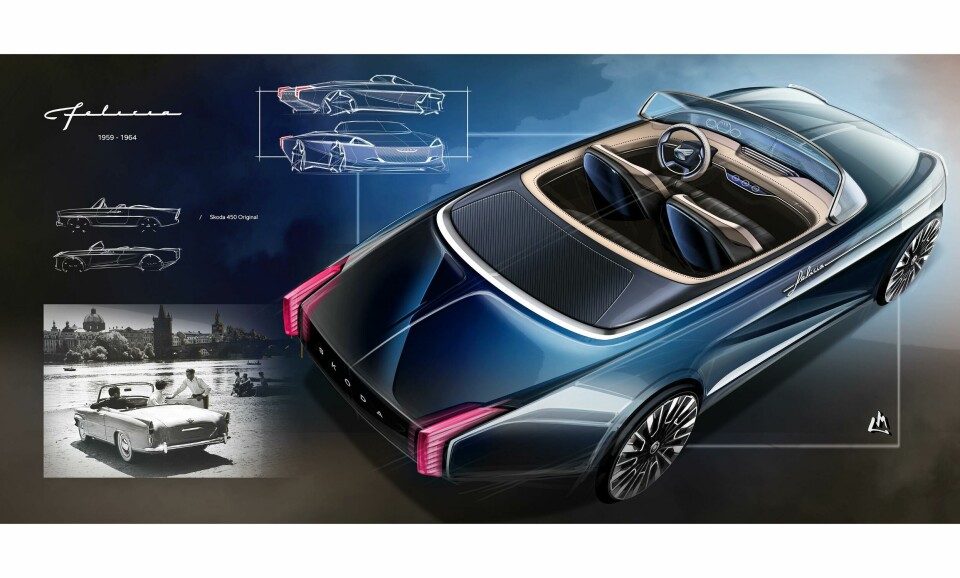
A trip down Skoda’s memory lane – designers breath new life into old icons
A collection of historic Skoda models have been re-imagined and re-designed with modern adaptations
A team of designers at Skoda have started a makeover project taking the brand’s best-known models and giving them a modern design twist. So far, the team has re-imagined five models.
Voiturette
The Voiturette A was first ever car created by Laurin & Klement, which would later become Skoda. It made its debut on 29 October 1905 before being shown at the 1906 Prague Motor Show. A two-seater that produced 7hp and had a top speed of 40kph, the Voiturette A included design details that were typical of the time, such as the wooden cabin and leather throne. It was the first in a long line of carriage-esque models that the company produced, with a staggering 18 other cars unveiled between 1906 and 1915, all of which used a similar shape and build as the Voiturette A.
Yuhan Zhang, interior designer at Skoda, has re-imagined the model and sketched it as a fully autonomous car that takes tourists around the city of Prague. Inside, a large touchscreen takes the place of the steering wheel, and provides passengers with sightseeing information. The wood has been replaced with modern fabrics, but the same throne-style seating arrangement remains.
1203 Camper
Skoda’s 1203 van debuted on 14 September 1968 at an engineering trade show in Brno – a city in the south east of the Czech Republic. It had a one-box design in which the engine was placed at the height of the front seats to prevent the engine compartment from protruding into the cabin. The model was originally produced as a delivery van, but many different variants were made due to the flexible design, such as a workshop vehicles, microbuses and ambulances.
Daniel Hájek, interface designer at Skoda, has turned the iconic van into a camper. He has taken cues from the original design, such as the beak-like shape of the front end and rounded roof panel, but modernised the appearance with an angular light signature and protruding wheel arches.
Felicia Cabriolet
The convertible Skoda Felicia made its debut at the Spring Fair in Leipzig, Germany, on the 1 March 1959. It sat alongside the Octavia, and although the open-top version has long since been discontinued, it still looks like a beautiful piece of design work. The large rounded bonnet and circular lamps characterised the front end, while clean lines along the sides resulted in the distinctive fins at the rear.
Martin Leprince, interior designer at Skoda, has brought new life to the model. Many of the exterior details remain, such as the bold lines on the sides and the rear fins. Inside, however, an overhaul of the dash sees an enormous screen stretch from door to door, encompassing the front passengers. There is also a clear focus on plush materials and comfort.
Popular Monte Carlo
“An elegant model with rally DNA” – Skoda’s description of the Popular Monte Carlo. Launched in 1936, the model made its world premiere at the Paris Motor Show on 1 October after having taken second place at the Monte Carlo Rally back in January. It looks like a Bond villain’s car, with a giant grille and two giant lights dominating the front end. The long bonnet and curvy wheel arches are suitably flamboyant, while the sloping rear extends dramatically towards the ground.
Taking on a very different form, the re-imagined model penned by Skoda interior designer Ljudmil Slavov is far more streamlined and sportier. It is almost unrecognisable but for some subtle hints to the old design, such as the long bonnet and boisterous wheel arches.
130 RS
Dubbed the “Porsche of the East”, Skoda’s 130 RS took to the rally circuit in 1975. The model was based on the 110 Rl, and was powered by a 1.3-litre engine that produced 140hp. It was able to reach a top speed of 220kph.
Aymeric Chertier is a lead architecture designer at Skoda. His interpretation of the old model includes many of the same attributes, like the large overhang at the back and the clean, driver-centric interior. There is even a giant racing gearstick. However, Chertier has injected a modern twist with the lighting signature, flared wheel arches and huge touchscreen inside.
Skoda says it has “no specific plans to develop any of the designs created as part of the icon project.” However, we have seen many other companies reviving old nameplates of late, such as the GMC Hummer EV, Ford Bronco, Land Rover Defender, Tata Sierra, and Renault 5.































